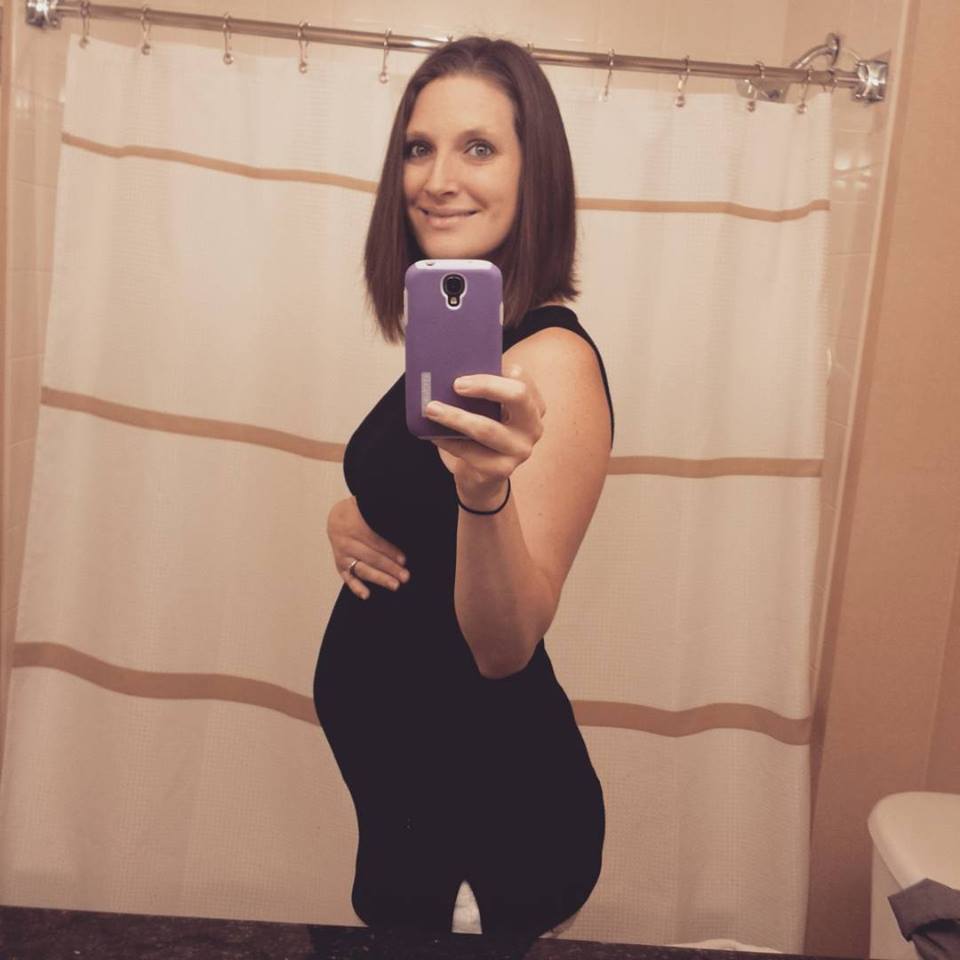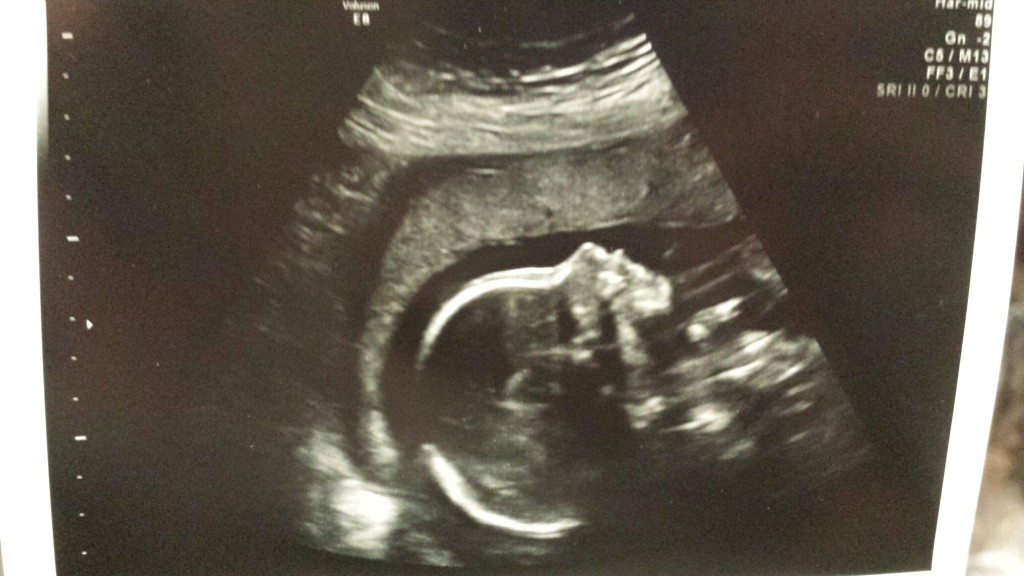Going into our 20 week ultrasound appointment, we already knew that we were having another baby girl {thanks to amazing advancements in technology}, but that didn’t mean I was any less excited for our anatomy scan. I couldn’t wait to get another glimpse of our beautiful baby girl and see how big she was getting. The pregnancy was going great so far, I was enjoying all of the little kicks {even if they were to my bladder} and I had no reason to believe that anything would be wrong. In the back of my mind, I was a little bit worried that something could be wrong because you hear of so many stories, but I assured myself that it couldn’t happen to me. I know you have to be optimistic or else you will drive yourself crazy with all of the possibilities, right?

We were halfway through our anatomy scan and, I have to be honest, I wasn’t happy with the technician. She seemed very nervous, and while she seemed to know what she was doing, she didn’t seem very confident about it. She got terrible pictures. It didn’t make me feel very comforted that she was making sure everything was okay. She kept commenting on how the baby wasn’t in a good position for her to do the scans, as if it was my fault. She finally finished her scans, said everything looked good, and then we waited for the doctor to come in to take a second look.
My doctor focused on a certain spot for what seemed like forever, then turned off the machine, and told me to get dressed so that we could discuss the results. Well, you know that doesn’t sound like good news. My heart started racing and a million scenarios started running through my head of what could be wrong.
My doctor explained that the baby had what looked like to be an isolated echogenic bowel. Which means that everything else looked great {therefore, isolated}, but that the bowel is almost as bright as the surrounding bone. According to the Society for Maternal-Fetal Medicine, isolated echogenic bowel is found in approximately 0.5% of fetuses and is a nonspecific finding {meaning people don’t really know what it means and it could be nothing} and is observed in 0.2%-1.8% of routine second trimester ultrasounds. The chances are so low, but we were being faced with it. My doctor assured me that in most cases, this is a completely normal {transient and idiopathic} finding, but that it could also indicate a number of abnormalities, such as:
- Down’s Syndrome
- Cystic Fibrosis
- Intrauterine Growth Restrictions
- Bowel obstruction {requiring surgery upon birth}
- Toxoplasmosis
- Cytomegalovirus {also known as CMV}
Cue me freaking out.
All of my first trimester screenings were negative for Down’s Syndrome and Cystic Fibrosis, so my doctor ruled that out. The baby was a perfect size, so he ruled out any growth issues. Toxoplasmosis could be a possibility and comes from cleaning cat litter boxes or from eating rare red meat, but I haven’t had contact with either of those. My doctor said I should get blood tests for CMV because that would be the most likely explanation. He again reassured me that echogenic bowel could be a completely normal finding and it would end up being nothing, but that we should run the tests, just in case. He sent me for bloodwork to test for CMV and told me to come in for a follow-up ultrasound in 2 weeks.
So, the question is – what is CMV? Have you ever heard of it? Neither had I, my husband, or anyone I mentioned it to. My doctor went through and explained it in detail to me, which I am very grateful for. The purpose of this post is to make you aware of CMV because although pregnant women are educated on all of the everyday things that can affect your pregnancy ranging from deli sandwiches to sushi to cat litter boxes to certain types of fish, you are never told about the dangers of CMV.
According to the CDC, CMV is a common virus that infects people of all ages that is usually harmless to people with a healthy immune system. The CDC says that 50-80 percent of people in the United States are infected by the time they are 40 years old. Most people have no symptoms, but some could have similar symptoms to mononucleosis {mono}. Once you contract CMV, it lives dormant in your system forever, similar to mono and chicken pox. But again, you won’t know that you have it unless you are tested. About 1 in 150 babies are born with CMV that was transmitted from the mother and 1 in 5 of those babies will develop permanent problems such as hearing loss or developmental disabilities.
It amazed me that I had never been warned against CMV, yet it could have a devastating impact on my baby. It could also have no effect on the baby, but you won’t know that until birth or possibly a few years later on. It is listed on the CDC website as 1 of 3 prenatal infections, along with Group B Strep {doctors give routine tests for this} and Listeriosis {hence no cold cuts}, which pregnant women are both thoroughly educated about. So why aren’t we told about CMV? Pretty scary, right?
If a pregnant women has not had a recent CMV infection, the likelihood of it being passed to the fetus is very low, and is not a cause for concern. It is, however, more of a cause for concern if you contract the primary infection when you are pregnant {or nursing}.
I bet you’re wondering how you get exposed to CMV…I know I was pretty curious to know how I could have gotten this “silent” virus that over half the population also shares but doesn’t know about. The CDC says the virus is not highly contagious, but has been known to spread among household members. Guess what he said next? I could have gotten it from kissing my toddler or sharing a drink with her. That broke my heart. He said that it is very common to be exposed to CMV from children under 6. Well, my doctor knew I had a 2 year old at home – why was I not told about CMV? It turns out that moms of toddlers are at risk for being exposed to CMV! Considering that 2-3 years is a common age gap, it is surprising that doctors do not mention the dangers.
The CDC provides the following guidelines to pregnant or nursing women to avoid exposure to CMV:
- Avoid contact with saliva when kissing a young child. For example, kiss on the forehead or cheek rather than the lips.
- Don’t put anything in your mouth that have been in a child’s mouth, including food, cups, forks, spoons, or pacifiers.
- Wash your hands after touching a child’s saliva or urine especially after wiping a child’s nose or mouth or changing diapers.
- If you do not have soap and water, use an alcohol-based hand sanitizer.
You’ve all gotten the pamphlets on food restrictions from your doctor, right? But how many of you gotten a pamphlet that told you to avoid kissing your toddler on the lips?
It’s kind of obvious that everyone should be washing their hands after changing diapers. But I constantly kiss my daughter on the lips and she shoves just about anything in my mouth because she likes sharing with mommy. However, just as I stay away from cold cuts, alcohol, and sushi, I would have tried my best to follow these guidelines if I had been educated about CMV.
Pregnant women with a lot of contact with children, such as preschool teachers, daycare workers, nurses, etc. need to be aware of it so that they can limit their contact. A lot of resources encourage all pregnant women to learn their CMV immunity status so that they are able to know if they have previously been infected by it or if there is the potential to get a primary infection during pregnancy, so that they can ensure to take steps to avoid being exposed.
So I went for bloodwork to test for a primary CMV infection during pregnancy. The wait to get the results felt like forever. During the wait, I spent hours reading up online about CMV, such as from The CMV Action Network, How Life Happens Blog and The Texas Children’s Hospital Blog, which were all really helpful. I also read a post from Houston Moms Blog from a fellow blogger mama that went through a primary CMV infection during pregnancy. Usually you should stay away from “googling” any health issues, but googling CMV and pregnancy actually reassured me because I was able to get more educated about something I felt that I should have learned about from my doctors, especially since they knew I had close contact with a young child {that attends daycare}.
I finally got the results that all test results point to that I was exposed to CMV at some point in my life, but that I did not get a primary infection during pregnancy. Cue a sigh of relief, but we still had to wait to see if the echogenic bowel cleared up in the next ultrasound because there could still be an issue. We went back 2 weeks later for the follow-up ultrasound and there was no evidence of an echogenic bowel. The doctor also checked if there were any other CMV markers and he confirmed that there weren’t.

My doctor said that if he saw me that day instead of 2 weeks prior, there would have been no abnormal findings. Well, that felt great to hear! However, I was happy that we had the abnormal finding 2 weeks prior because I got to learn about CMV. I think every pregnant women should know about it so that they can decide on their own what preventative steps they want to take, which is why I’m sharing my story with you.
My doctor acknowledged that pregnant women are not properly educated about it, merely because the effects to a fetus are not widely understood. Even if the tests had come back positive for a primary infection during pregnancy, we still wouldn’t know what effect it would have on the baby once it was born. There are experimental treatments for it, but unfortunately nothing that is widely marketed.
I luckily had a happy ending, but there are others that don’t. I am grateful for having a doctor look at my ultrasound who was thoroughly educated and was able to explain everything to me. I hope that others have the same experience if they ever go through this. I hope some of you reading will benefit from my story.
Please share this with your fellow pregnant mamas and soon-to-be pregnant mamas to spread the word so that everyone can be educated about CMV.




























What a fantastic blog post. I live in New Canaan and unfortunately have a daughter born with disabilities due to CMV. Yes, our doctors need to start education their patients on preventable techniques!! I know too many local families who have children also born with disabilities from CMV. The response is always “Why? Why did no one tell me about this?” I’m so thrilled for your happy ending and thank you so much for helping to spread the word.
Casey, I am so sorry to hear this about your daughter and other families that you know. I really wish that every OB would educate their patients on CMV. Yes, it’s not well known what the effects will be, but does that mean that we shouldn’t try to prevent it? I find it so appalling especially when a mother has young children at home that she isn’t educated about it or tested. They prick us almost every time at the doctor for blood… I know I wouldn’t have minded an additional test at all!
Great post! I was initially exposed to CMV during my second pregnancy, and had a toddler under two at the time. I lost her at 23 weeks. I’m glad to hear you outcome was the opposite of mine.
My daughter was born with hearing loss and it was determined through a urine test at 4 weeks that she did, in fact, have CMV. I, too, have a toddler so that’s probably how I contracted it. Like you, everybody I have ever told about CMV has never heard of it. And why not?! We are lucky that hearing loss was my daughter’s only disability. But, why don’t they test for it when they do all of the blood work at the beginning of your pregnancy?
… [Trackback]
[…] Informations on that Topic: fairfieldcounty.momcollective.com/cmv-silent-virus-every-pregnant-woman-know-doesnt/ […]
I read your blog post and found it very insightful, personal, and informative !
You did a grreat job sharing your experiences and promoting cmv awareness !
CMV is indeed the most common virus most people never hear about – – and pregnant women must know about!!
I am sharing this !
Dr Gail Demmler Harrison
CMV DOC
Aarika-
I am going through an echogenic bowel scare right now and the unknown is taking a toll on me. I came across your story and it is giving me hope that all will be fine. Can u email me? I would love to ask u further questions about how your doctor handled the situation and what tests you were given.
Lauren, I am so sorry to hear that you are going through this, but I am glad that you found my post! I would love to connect, please e-mail me at [email protected].
Currently going through this now. I too have a 3year old daughter who goes to nursery. Unfortunately as I live in jersey ( Channel Islands not New Jersey USA) I have to wait 3-4 weeks to get the full results as they are sent to the UK for testing….. I never heard of CMV until one of the unhelpful consultants brushed over it whilst mentioning what they were testing for- but no explanation to what it was! Fingers crossed everything come back ok!
Lucy, I hope everything comes back okay.
Hi,
Thanks for sharing this information. There are some conferences happening in which medical specialty would be Maternal-fetal medicine and here is one of those conferences the conference details are given below.
Join and meet physicians and sonographers in the fields of gynecologic and obstetric imaging in Fetal and Women’s Imaging – Advanced OB-GYN Ultrasound 2020 which is held from Sep 25 – 27, 2020 at Seattle, Washington, USA.
For more information please follow the below link:
https://www.emedevents.com/c/medical-conferences-2020/fetal-and-women-s-imaging-advanced-ob-gyn-ultrasound-2020